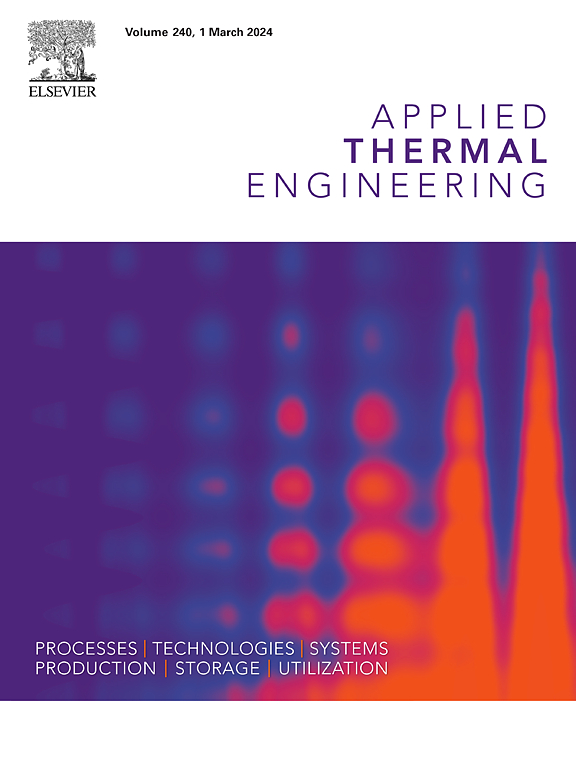Numerical simulation and sensitivity analysis of hot air drying for irregular flake materials based on fully coupled of multi-physics fields
IF 6.1
2区 工程技术
Q2 ENERGY & FUELS
引用次数: 0
Abstract
The multi-physics coupling mechanisms of irregular flake materials during hot air drying remain unclear. Therefore, a three-dimensional thermal-mass-mechanical bidirectional fully coupled model was established in this study, incorporating shrinkage deformation, dynamic porosity variations, and their feedback effects on heat and mass transfer. The model’s accuracy was validated through experiments, systematically revealing the spatially asymmetric distribution characteristics of temperature-moisture fields and stress–strain fields in materials of different sizes, along with their dynamic evolution patterns associated with structural features. The interaction mechanisms between material dimensions and drying parameters were elucidated. Sensitivity analysis using the OAT method quantified the influence of key parameters on the drying process. The research demonstrates that small-sized materials exhibit uniform thermal-moisture distribution and low stress–strain characteristics due to their high specific surface area and short mass transfer paths, while large-sized materials show significantly increased thermal and moisture stresses with stress concentration prone to occur at concave regions. Moisture stress dominates shrinkage deformation, showing positive correlations with both material size and temperature. Material size exerts a more pronounced influence on drying efficiency compared to temperature. Sensitivity analysis reveals that small-sized materials demonstrate significantly higher sensitivity to external parameters than large-sized ones, while large-sized materials are more affected by Poisson’s ratio and thermal conductivity. Young’s modulus regulates stress states but shows no correlation with the timing of stress peaks. The study further proposes separating small-sized materials from medium/large ones during drying processes, and optimizing drying temperature and mass transfer conditions to balance porosity changes with stress concentration, thereby enhancing drying uniformity. This research provides theoretical support from a multi-physics coupling perspective for optimizing drying processes, inhibiting shrinkage deformation, and improving product quality, offering practical guidance for relevant industrial applications.
基于多物理场全耦合的不规则片状物料热风干燥数值模拟及灵敏度分析
不规则片状材料在热空气干燥过程中的多物理场耦合机制尚不清楚。因此,本研究建立了一个三维热-质-机双向全耦合模型,将收缩变形、动态孔隙率变化及其对传热和传质的反馈效应纳入其中。通过实验验证了模型的准确性,系统地揭示了不同尺寸材料中温度-湿度场和应力-应变场的空间非对称分布特征,以及它们与结构特征相关的动态演化模式。阐明了材料尺寸与干燥参数之间的相互作用机制。使用 OAT 方法进行的敏感性分析量化了关键参数对干燥过程的影响。研究表明,小尺寸材料由于比表面积大、传质路径短,因此热湿分布均匀,应力应变特性低;而大尺寸材料的热应力和湿应力显著增加,应力集中易发生在凹面区域。湿应力主导收缩变形,与材料尺寸和温度呈正相关。与温度相比,材料尺寸对干燥效率的影响更为明显。敏感性分析表明,小尺寸材料对外部参数的敏感性明显高于大尺寸材料,而大尺寸材料受泊松比和热导率的影响更大。杨氏模量对应力状态有调节作用,但与应力峰值出现的时间无关。研究进一步建议在干燥过程中将小尺寸材料与中/大尺寸材料分开,并优化干燥温度和传质条件,以平衡孔隙率变化与应力集中,从而提高干燥均匀性。这项研究从多物理场耦合的角度为优化干燥过程、抑制收缩变形和提高产品质量提供了理论支持,为相关工业应用提供了实际指导。
本文章由计算机程序翻译,如有差异,请以英文原文为准。
求助全文
约1分钟内获得全文
求助全文
来源期刊

Applied Thermal Engineering
工程技术-工程:机械
CiteScore
11.30
自引率
15.60%
发文量
1474
审稿时长
57 days
期刊介绍:
Applied Thermal Engineering disseminates novel research related to the design, development and demonstration of components, devices, equipment, technologies and systems involving thermal processes for the production, storage, utilization and conservation of energy, with a focus on engineering application.
The journal publishes high-quality and high-impact Original Research Articles, Review Articles, Short Communications and Letters to the Editor on cutting-edge innovations in research, and recent advances or issues of interest to the thermal engineering community.
 求助内容:
求助内容: 应助结果提醒方式:
应助结果提醒方式:


